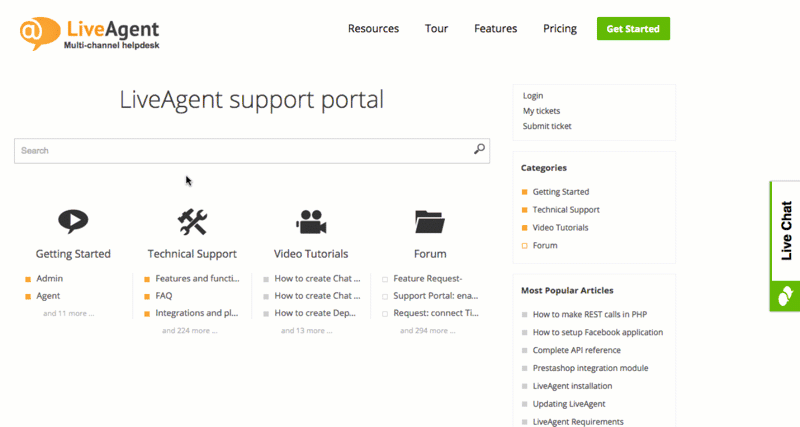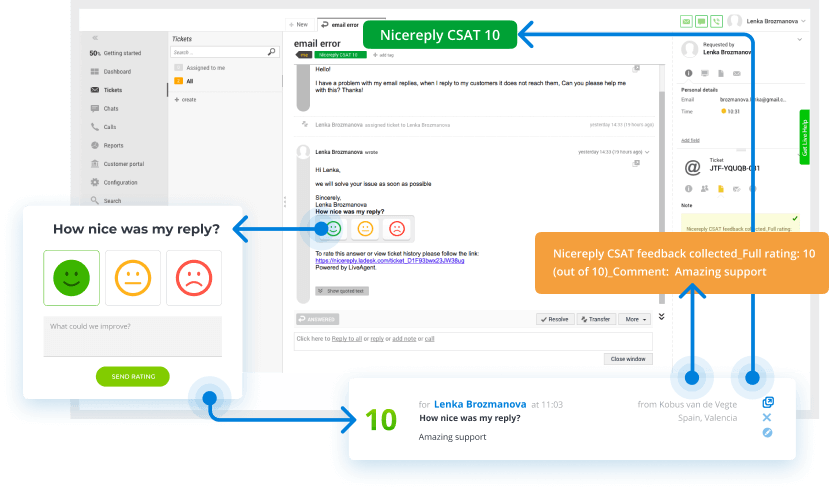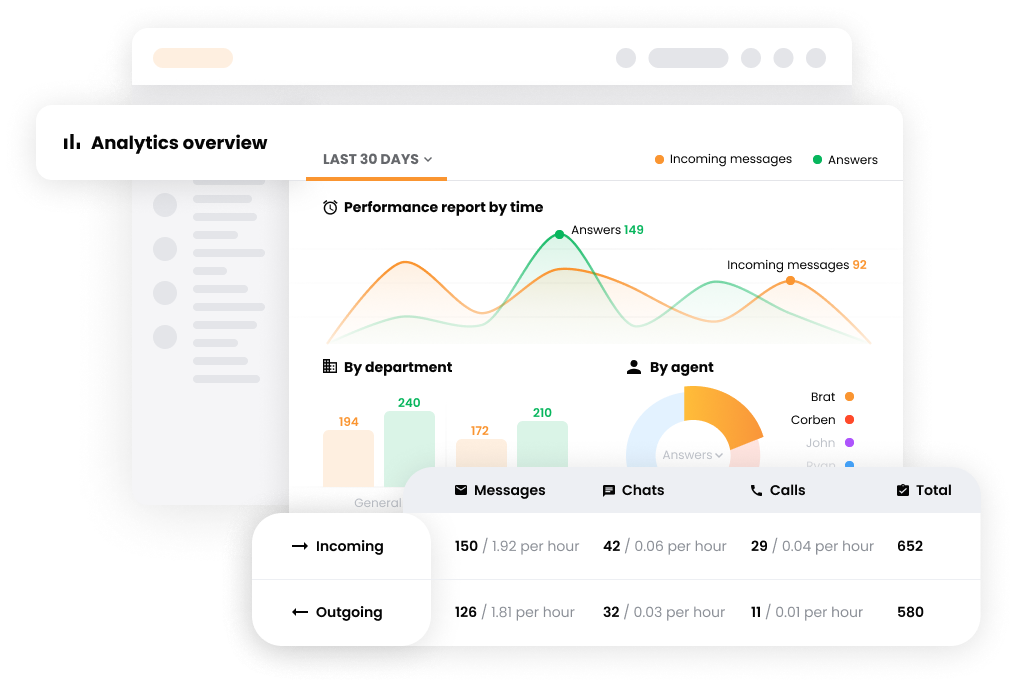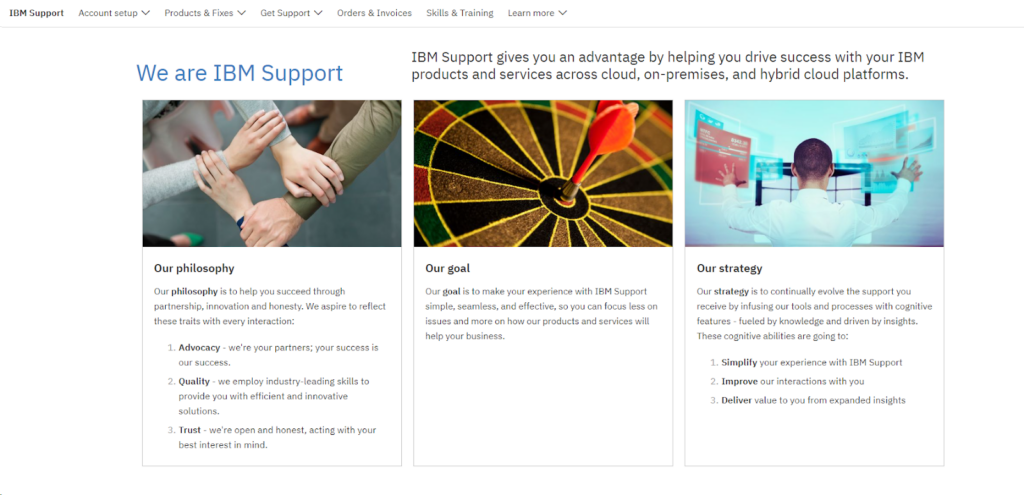In an era where customer expectations are rising rapidly, setting clear goals for customer service is not just beneficial; it’s essential. The landscape of customer service will continue to evolve, driven by technological advancements and the ever-changing needs of consumers. By 2025, businesses will need to redefine their service strategies to stay ahead.
To thrive in this competitive market, companies must focus on quantifiable objectives that not only enhance customer satisfaction but also streamline their operations. SMART goals—Specific, Measurable, Achievable, Relevant, and Time-bound—serve as a powerful framework for establishing clear targets that drive meaningful improvements.
In this article, we will explore 15 crucial customer service goals for 2025, complete with practical examples. Additionally, we will demonstrate how LiveAgent can serve as your ultimate solution for achieving these objectives. Prepare to transform your customer service approach and build lasting customer relationships.
Table of Contents
Setting SMART goals for customer service
When it comes to enhancing customer service, setting SMART goals is essential for aligning your team’s efforts with the overall mission of your organization. Here’s how to effectively create SMART goals that drive improvement and increase customer satisfaction.
1. Specific
The first step in setting a SMART goal is to ensure it is specific. A specific goal clearly defines what you want to achieve and eliminates any ambiguity. For example, instead of saying, “Improve customer service,” a more specific goal would be, “Reduce average response time to customer inquiries to under 2 hours.” This clarity gives your team a defined target to work toward.
2. Measurable
This means you need to establish criteria for tracking progress and success. For instance, instead of saying, “Improve customer satisfaction,” you could set a goal like, “Achieve an 85% customer satisfaction score on post-service surveys by the end of Q3.” By quantifying your goal, you can assess whether you are on track to achieve it and make necessary adjustments along the way.
3. Attainable
Setting attainable goals is crucial to maintaining motivation within your team. A goal should be challenging yet achievable based on your current resources and capabilities. For example, if your current average customer satisfaction score is 70%, it may be unrealistic to aim for 100% immediately. A more attainable goal could be, “Increase customer satisfaction by 10% over the next year.” This gives your team a realistic target while still pushing for improvement.
4. Relevant
Your goals should align with the broader objectives of your organization. This relevance ensures that efforts made by the customer service team contribute to the overall success of the business. For example, if your organization is focused on increasing customer retention, a relevant goal could be, “Reduce customer churn by 15% through enhanced follow-up procedures and personalized communication by year-end.” This way, the customer service team’s efforts are directly linked to the company’s strategic objectives.
5. Time-bound
Finally, every goal should have a clear deadline. This time constraint creates a sense of urgency and encourages focus. For example, instead of saying, “Train staff on effective communication,” a time-bound goal could be, “Complete training for all customer service representatives on effective communication techniques by the end of Q2.” Having a specific timeframe helps your team prioritize tasks and stay accountable.
Example of a SMART Goal
To illustrate the application of the SMART criteria in customer service goal-setting, consider the following example:
- Specific: Train customer service representatives to handle complex queries.
- Measurable: Achieve a 90% competency level in the post-training assessment.
- Attainable: Provide 10 hours of targeted training sessions over two months.
- Relevant: Aligns with the company objective of enhancing customer support quality.
- Time-bound: Complete training program by the end of Q2.
15 Customer service goals for 2025
In 2025, customer service goals will pivot toward creating more personalized experiences. By leveraging AI, companies aim to tailor solutions for 80% of interactions. Additionally, omnichannel support will be essential, ensuring a seamless experience across all customer service points. Proactive service efforts will focus on identifying potential issues early, thus enhancing customer satisfaction by 15%. Sustainability will also be on the agenda, with a target of reducing the environmental impact by 20%.
Goal 1: Optimize first response time
Fast response time shows customers their time is valued. The goal here could be to answer 90% of inquiries within an hour during business hours. Studies reveal that 90% of customers want an immediate response. Tools like Smart Rules and SLA management can help achieve this. Such strategies lead to improved First Response Time (FRT) and Average Resolution Time, benefiting the entire customer service department.
One of the key ways to reduce first response time is through automation. LiveAgent comes equipped with robust automation features that allow businesses to streamline their ticketing process. By setting up automated responses for common inquiries, businesses can ensure that customers receive immediate acknowledgment of their requests, even if a detailed answer takes a little longer. This instant recognition can significantly enhance the customer experience, as it shows that their inquiry is being prioritized.

LiveAgent facilitates smart ticket routing based on predefined rules. This feature ensures that incoming inquiries are directed to the most suitable agent based on their expertise and availability, minimizing delays. For instance, if a customer query pertains to technical support, it can automatically route to an agent skilled in that area. This targeted approach not only accelerates response times but also increases the likelihood of a satisfactory resolution on the first interaction.
Goal 2: Increase customer satisfaction scores
Customer satisfaction is key to loyalty and retention. Happy customers spend more, boosting revenue. Set goals around metrics that build trust, such as response times and first-contact resolution rates. Regular goal reviews, whether monthly or yearly, keep satisfaction objectives relevant and allow for necessary adjustments, ensuring continuous improvement.
One effective way to achieve this is by leveraging tools that enable seamless communication and quick resolution of issues. LiveAgent software can play a pivotal role in this strategy. By providing a centralized platform for customer inquiries across various channels, including email, live chat, and social media.
Goal 3: Implement an omnichannel support system
Most customers prefer switching between channels, such as starting a chat on a website and continuing it via email. An omnichannel system meets this demand, preventing frustration and potential customer loss. Investing in customer service software like LiveAgent can provide a seamless experience, enhancing satisfaction and loyalty.
Implementing an omnichannel support system involves creating a seamless customer experience across various communication channels. This requires careful planning and execution, ensuring that all channels work together cohesively to address customer needs. Here’s how you can approach this implementation effectively:
Steps to Implement an Omnichannel Support System
- Identify Customer Preferences:
Begin by analyzing customer data to understand preferred channels. Use surveys, website analytics, and social media engagement metrics to gauge where your customers are most active. This insight allows you to prioritize which channels to implement first.
- Integrate Technology:
Leverage omnichannel customer service software to integrate various communication channels. This integration ensures that customer interactions across email, chat, social media, and phone calls are connected and that agents have a complete view of customer interactions, regardless of the channel used.
- Set Up Key Channels:
Start with the most popular channels identified in your analysis. Consider implementing:
- Chatbots: Use AI-powered chatbots to handle FAQs and provide 24/7 support, allowing for immediate assistance at any time.
- Messaging Apps: Integrate with platforms like WhatsApp and Facebook Messenger to reach customers where they already spend time.
- Social Media Support: Engage with customers on platforms such as Twitter, LinkedIn, and TikTok, providing timely responses to inquiries.
- Video Chat Support: Offer personalized assistance through video calls for a more interactive experience.
- Monitor and Optimize:
Establish key performance indicators (KPIs) to measure the effectiveness of your omnichannel strategy. Metrics may include incoming ticket volume per channel, individual channel response times, and customer satisfaction scores. Regularly analyze this data to refine processes and improve customer experiences.

Goal 4: Enhance employee training programs
Training is vital for effective customer service. Programs should cover product knowledge, common customer issues, and communication skills. Workshops and simulations reinforce ability, ensuring agents are prepared for any scenario. This investment leads to fewer escalations and more personalized, empathetic interactions. Regular reviews can identify gaps in agent performance, leading to targeted training improvements.
Develop a structured training curriculum that covers essential topics such as product knowledge, customer service etiquette, conflict resolution, and effective communication skills. By providing a well-rounded education, agents can feel more confident and prepared to handle a variety of customer inquiries.
Incorporate interactive learning tools such as simulations, role-playing exercises, and real-life case studies into the training program. These methods allow agents to practice their skills in a safe environment, boosting their confidence and competence before they handle actual customer interactions.

LiveAgent offers a comprehensive help desk solution that includes features such as ticket management, live chat, and a built-in knowledge base. These tools can be integrated into training sessions, allowing agents to familiarize themselves with the software they will be using on the job.
Striving to reach your customer service goals?
Join LiveAgent's 30-day free trial. Turn customer service goals into achievements now!
Goal 5: Foster a customer-centric culture
Cultivating a customer-centric culture involves setting clear service goals that prioritize customer needs and feedback. This mindset breaks down silos, encouraging teamwork to provide excellent service. Regular meetings to discuss progress foster a collaborative culture focused on improving customer experiences, turning satisfied customers into brand advocates.
Regular training sessions that focus on customer service excellence can help instill a customer-centric mindset throughout the organization. These sessions should not only cover customer service skills but also emphasize the importance of empathy and understanding customer perspectives.
A truly customer-centric culture requires collaboration across all departments. When marketing, sales, and support teams work together, they can create a seamless customer journey that is responsive to customer needs at every touchpoint.

LiveAgent integrates various communication channels, allowing teams from different departments to collaborate efficiently on customer interactions. The software’s shared inbox feature ensures that all relevant team members are updated on customer queries and issues, fostering teamwork and improving the overall customer experience.
Goal 6: Reduce customer wait times
Reducing wait times prevents customer frustration and potential abandonment of service requests. Strategies include asynchronous support and self-service options like AI chatbots. Each channel should have specific wait time goals, thus speeding up resolution processes and enhancing the overall customer experience. A robust helpdesk system can help prioritize and manage requests efficiently.
Customer service agents should access all customer interactions from a unified platform, significantly reducing the time spent switching between different systems. The seamless integration not only accelerates response times but also ensures that customers do not have to repeat their queries when they contact support through different channels.
LiveAgent allows businesses to maintain an omnichannel customer experience by integrating communication across email, chat, phone, and social media.

Self-service resources enable customers to find answers to their questions without waiting for agent assistance, effectively reducing the volume of inquiries directed at support teams. By investing in self-service options, businesses can enhance customer satisfaction while also decreasing service demand.
Goal 7: Improve customer feedback mechanisms
Effective feedback-gathering methods include CSAT surveys and user interviews. Analyzing this data can guide the refinement of services to align with customer needs. Companies must address both positive and negative feedback, showing their commitment to improvement. This continuous refinement relies heavily on feedback to understand and solve customer issues.
Strategies for Enhancing Customer Feedback Mechanisms:
- Diverse Feedback Channels: Offer multiple avenues for customers to provide feedback, such as post-interaction surveys, email follow-ups, social media engagements, and in-app rating widgets.
- Real-time Feedback Collection: Implement tools that allow for immediate feedback after interactions.
- Analysis and Reporting: Use analytics tools to compile and analyze feedback data systematically. Identifying trends and common pain points can help prioritize improvement areas and measure the effectiveness of changes made.
- Act on Insights: Communicating the results of customer feedback and showing how it has influenced decision-making can build trust. Customers are more likely to engage when they see their suggestions leading to tangible improvements.

LiveAgent software can streamline and optimize the collection and analysis of customer feedback. With its integrated ticketing system, businesses can track customer interactions and feedback in one place, allowing teams to respond quickly and efficiently.
Goal 8: Establish clear communication protocols
Clear communication aligns team efforts and boosts motivation. Simple language and specific timelines clarify roles and tasks. Transparency in goal communication helps the team stay committed and aligned with objectives. Regular updates celebrate achievements and address challenges collaboratively. This fosters a consistent and effective trajectory toward enhancing customer experiences.
Goal 9: Leverage data analytics for insights
Advanced analytics can predict customer needs, aiming to increase satisfaction scores by 15%. Real-time tools in customer service software, like LiveAgent, help monitor interactions immediately. By tracking KPIs such as satisfaction scores, businesses can assess their service efforts’ success. Customer feedback from various sources identifies strengths and improvement areas, guiding realistic goal-setting.

Goal 10: Strengthen customer relationship management (CRM)
Automation in CRM reduces repetitive tasks, allowing agents to focus on building relationships. Implementing CRM systems streamlines interactions, leading to quick resolutions and high-quality service. Handling complaints effectively restores trust. Collaborating with team members leverages diverse skills for problem-solving. Setting measurable goals ensures accountability and improves the customer experience.
One of the fundamental aspects of a strong CRM is the ability to collect and analyze customer data. By utilizing feedback mechanisms, such as surveys and follow-up calls, businesses can gain a clearer understanding of customer preferences, pain points, and satisfaction levels. This feedback can be instrumental in shaping service improvements and ensuring that customer needs are consistently met.
Moreover, personalized interactions are becoming increasingly vital in today’s customer-centric landscape. Implementing a CRM system allows businesses to track customer histories, preferences, and interactions, enabling agents to provide tailored responses that resonate with individual customers. This not only enhances the customer experience but also fosters loyalty and retention.

LiveAgent software, for instance, can streamline the process of managing customer interactions. By consolidating communication channels into a single platform, customer service teams can respond more efficiently to inquiries across various platforms, including email, live chat, and social media.
Goal 11: Encourage proactive customer engagement
Proactive engagement anticipates rather than reacts to customer needs. Using past data, companies can offer personalized outreach and recommendations. Metrics like engagement rates measure outreach success. Feedback on proactive communications assesses their impact on satisfaction. Consistency across touchpoints is crucial for creating an integrated customer experience.

Goal 12: Develop personalized customer interactions
Personalized interactions use customer data for tailored support. Agents trained in customizing service based on history and preferences foster a sense of recognition. Personalized interactions make onboarding smoother and deepen customer connections. This strategy enhances satisfaction and loyalty, reflecting a well-defined goal in personalization.
For instance, if a customer reaches out with a specific query, agents can quickly access their account history and previous support tickets. This context enables them to provide more accurate and quicker responses, fostering a sense of familiarity and care. Additionally, LiveAgent supports multiple communication channels—like email, live chat, and social media—ensuring that personalized interactions can flow seamlessly regardless of how a customer chooses to reach out.
Furthermore, businesses can utilize automation tools within LiveAgent to segment their customers and deliver targeted content and support based on these segments. For example, a new customer might receive a personalized onboarding guide tailored to their specific use case, while a long-time customer may benefit from special offers or loyalty rewards based on their purchase history. This level of customization is key to making customers feel appreciated and recognized, which can significantly enhance their overall satisfaction.
One effective approach to achieving this personalization is through the integration of customer service software like LiveAgent.
Real-life examples of effective customer service goal implementation
Of course, we can’t talk about customer service goals without mentioning a few brands that have mastered this practice.
Amazon
Amazon is renowned for its customer service goals. Their primary goal is to be “Earth’s most customer-centric company”. As such, Amazon’s approach to customer service is rooted in their customer-obsessed nature, with the primary goal of making the customer’s experience as seamless and satisfying as possible.
Amazon values and implements customer feedback to identify areas that require improvement. Their goal is not just to satisfy customers, but to earn their trust and build long-term relationships by prioritizing their needs and interests above all else. For Amazon, the customer is always the king.

Apple
Apple Inc., the renowned technology giant, excels not only in producing innovative hardware and software but also in providing exceptional customer service. Central to this customer-centric approach, Apple provides its employees with comprehensive directions on how to interact with customers.
Apple’s customer service goals methodology is encapsulated in the acronym APPLE:
Approach customers with a personalized greeting
Probe politely to understand all the customer’s needs
Present a solution for the customer
Listen for and resolve any customer issues or concerns
End with a farewell and an invitation to return

Zappos
Zappos is a leading online apparel and footwear retailer based in the United States. They gained prominence in the eCommerce world through their relentless focus on customer service. The company strongly believes that providing top-notch customer service is pivotal to its success. Their approach to customer service goals revolves around exceeding customer expectations, instead of just merely meeting them.
Zappos operates under ‘delivering happiness’, leading their customer service strategy with empathy, customer-centric policies, and generous return policies.

IBM
International Business Machines Corporation (IBM) is a multinational technology company providing a vast array of technology and consulting services. IBM’s approach to customer service is meticulously designed to be customer-centric, prioritizing the needs and goals of its clients. They are committed to delivering top-notch service quality, empowering clients with innovative solutions and transformative technology.
To achieve their customer service goals, they leverage advanced technologies and their deep industry expertise, tailoring solutions according to each client’s unique needs. Customer feedback is highly valued in their problem-solving approach, ensuring that their solutions continue to evolve and improve. IBM’s customer service strategy also includes extensive employee training to ensure that their workforce is well-equipped to deal with various client situations with empathy and proficiency.

Conclusion
By now, it should be clear that customer service goals are not an option, but an absolute necessity for any business aiming for sustainable growth and success. Whether you’re a manager looking to empower your team or an agent aiming to hone your skills, setting clear, SMART goals can significantly boost your performance and enhance your customers’ experience.
Customer service goals cover a wide spectrum, from adopting an omnichannel strategy and mastering channel-specific metrics to enhancing customer satisfaction, reducing customer wait time, and innovating alongside industry trends. Taking a transparent approach about client data and humanizing the customer experience are equally crucial goals to pursue in order to achieve excellence.
Remember that technology is your ally in this journey. Tools like LiveAgent can streamline the process of setting, tracking, and achieving customer service goals. With multichannel support, flexible automation, performance analytics, among many other features, LiveAgent helps you maintain the high quality of service that your customers expect. You can try LiveAgent 30 days free of charge and see for yourself, how your customer service goals prosper.
Striving to reach your customer service goals?
Join LiveAgent's 30-day free trial. Turn customer service goals into achievements now!
Frequently Asked Questions
How do you write a customer service goal?
A customer service goal can be written as: "To provide timely, efficient, and courteous service to all customers, aiming to resolve issues on the first contact and enhancing customer satisfaction levels by 20% over the next quarter." This goal is specific, measurable, achievable, relevant, and time-bound, following the SMART goal setting framework. It focuses on improving the quality of service and customer satisfaction, which are key aspects of customer service.
What are support objectives?
Support objectives are specific goals set by a support team to provide efficient and effective assistance to customers or clients. These objectives often include reducing response times, improving customer satisfaction rates, and increasing the resolution rate of issues. They serve as a guide to ensure the support team is meeting the needs and expectations of the customers.
What are the main goals of a support team?
The main goals of a support team are to resolve customer issues efficiently and effectively, to provide excellent customer service that enhances customer satisfaction, and to contribute to the overall customer experience by offering guidance and support that helps customers make the most of a product or service.
How do you create a customer service strategy?
Creating a customer service strategy involves understanding customer needs through data analysis and feedback, setting goals such as improved response times and customer satisfaction, and defining necessary resources like trained staff and technology. Regular evaluation and adjustment of the strategy ensures its effectiveness in meeting evolving customer needs. This cyclic approach contributes to continuous service improvement.
Share this article
Smart customer satisfaction software
Boost customer satisfaction in 2025 with LiveAgent! Deliver personalized, 24/7 support on every channel. Free trial, no credit card needed.

 Български
Български  Čeština
Čeština  Dansk
Dansk  Deutsch
Deutsch  Eesti
Eesti  Español
Español  Français
Français  Ελληνικα
Ελληνικα  Hrvatski
Hrvatski  Italiano
Italiano  Latviešu
Latviešu  Lietuviškai
Lietuviškai  Magyar
Magyar  Nederlands
Nederlands  Norsk bokmål
Norsk bokmål  Polski
Polski  Română
Română  Русский
Русский  Slovenčina
Slovenčina  Slovenščina
Slovenščina  简体中文
简体中文  Tagalog
Tagalog  Tiếng Việt
Tiếng Việt  العربية
العربية  Português
Português 

